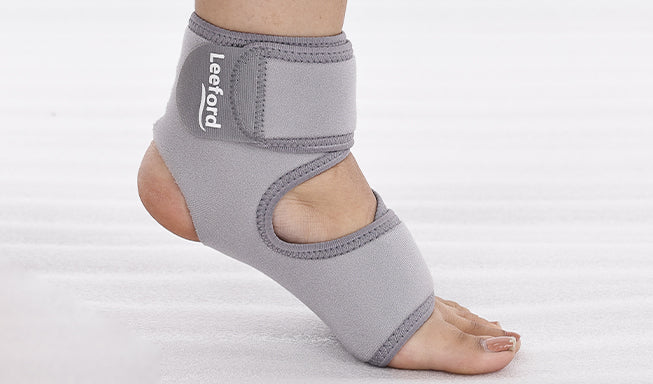Ankle injuries, from a slight sprain during a jog to a more severe twist on the sports field, can be a nagging and painful reality for many. It is a common fact that every step forward begins with the right support. Whether you’re an athlete, a dancer, someone constantly on the move, or leading an active lifestyle, etc.
In such cases, a quality ankle brace offers a beacon of hope for swift recovery and future protection; its efficacy is entirely dependent on its correct application. Here is the catch, don't let your investment go to waste by falling prey to common, yet easily avoidable, errors. This blog is dedicated entirely to the vital ankle brace do's and don'ts that can mean the difference between a quick recovery and a prolonged, frustrating healing process.
The Foundations of Proper Ankle Brace Use
It is crucial to understand the proper usage of an ankle brace, especially, anyone needing support, from athletes to those recovering from an injury. Here's a user-friendly ankle brace fitting guide to help you get it right.
1. Choosing the Right Size and Type
It is a common occurrence when you order an ankle brace, but due to some reasons, it turns out to be an improper fit. Here's where you commit a mistake, knowingly using that brace without paying attention to it. If it's too loose, it won't provide adequate support, and if it's too tight, it can restrict circulation.
Leeford Ortho Support Tip: Leeford Ortho ankle supports offer various sizes based on ankle circumference. To find your perfect fit, you need to measure the circumference of your ankle just above the bone. This helps to achieve the right support with the right compression level and healing in the right direction. Apart from this, Leeford Ortho orthopedic supports offer adjustable straps, using which one can get the ease of a customized fit. Also, it offers a balance between stability and comfort for a quick recovery.
2. Wearing it Over Socks
The question, "Can I wear my ankle brace without socks?", is frequently asked, and the answer is a resounding no.
- Wearing the brace without a thin, moisture-wicking sock can lead to skin irritation, blisters, and chafing.
- The socks act as a protective barrier, keeping the skin clean and dry and preventing odor buildup.
How to Wear an Ankle Brace Correctly
Once you have the right brace, a proper application is key to ensuring its full effectiveness.
Preparation: Put on a thin, moisture-wicking sock.
Positioning: Sit down and slide your foot gently into the brace, while ensuring that your heel is comfortably and correctly positioned within the designated opening.
Securing: If it's a lace-up brace or like a figure 8 pattern, then tighten the laces snugly, but not so tight that they cut off circulation.
Straps: Make sure that if the brace has straps (like many Leeford Ortho supports). If there are no strap,s check for the right level of compression or the right size of the brace
Final & Comfortable Adjustments: Ensure the fit is snug but comfortable; it should allow for a good range of motion without restricting blood flow. You should be able to wiggle your toes.
Avoiding Common Mistakes that Reduce Effectiveness
Beyond the initial fitting, ongoing use requires attention to detail to prevent mistakes that reduce ankle brace effectiveness.
Mistake: Wearing it too Tightly
How tight should an ankle brace be? The brace should be snug, but not so tight that it causes pain, tingling, numbness, or leaves deep, lasting marks on your skin. You should be able to comfortably move your foot up and down, while sideways movement is limited.
Mistake: Wearing It for Too Long
Is it bad to wear an ankle brace all day? While useful for support during activity and recovery, wearing a brace 24/7 can cause muscle weakening. For recovery, you may wear it for most of the day for the first one to two weeks, but you should typically take it off at night to let your skin breathe. A softer compression sleeve can be used for mild support while sleeping, if needed.
Mistake: Not Cleaning It Regularly
How Often Should I Clean My Ankle Brace? This checks hygiene, well, regularly cleaning your brace is essential to maintain personal hygiene as well as your product hygiene and durability over time. One should opt the mild hand-washing by using a detergent or soap with cold water, which is generally recommended for cleaning purposes. Always allow it to air-dry completely, and avoid bleaching or exposing it to sunlight, which may ruin the elasticity of the product. This is particularly important for Leeford Ortho supports, which are made of skin-friendly materials.
When and How to Wear an Ankle Brace for Recovery
For effective ankle brace support tips, it's important to know when to start and stop using it.
How to Use an Ankle Brace for Injury Recovery?
- Initially, for acute injuries, prefer wearing the brace consistently during the day, or as advised by a doctor or physiotherapist.
- The braces, much like Leeford Ortho ankle supports, provide stability and limit excessive ankle movement. This, in turn, helps to reduce pain and swelling to promote quick recovery.
- As you progress, you can use the brace while you exercise to give you extra support and help you feel confident.
- You should pair the brace use with mild or recommended exercises. This helps to strengthen the ankle and prevent re-injury and further damage.
When Should I Stop Wearing an Ankle Brace?
- You should consider unwearing your ankle brace as soon as your ankle strength and stability start improving. Also, follow your doctor's advice and adapt according to the next step.
- The goal is for your ankle to become strong enough to support itself. If you're using it for preventive measures during high-impact sports, you can continue to do so, but for recovery, its use should decrease over time.
Conclusion
Ankle braces are an effective support for injury recovery and prevention. So, one needs to be patient and must follow the ankle brace fitting guide and carefully consider the key do's and don'ts. This helps to avoid those common mistakes that reduce ankle brace effectiveness. You can easily achieve it using the right size fit, wearing socks underneath, mindful use, and regular cleaning will ensure you get the most out of your support. No matter which types of braces support you use. Therefore, for a safe and speedy recovery, it's of great importance to know how to use your brace effectively, not just strapping it on.





